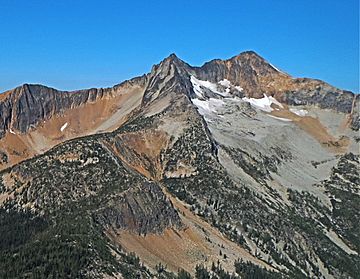Mount Lago facts for kids
Quick facts for kids Mount Lago |
|
|---|---|

Mount Lago from the east
|
|
| Highest point | |
| Elevation | 8,745 ft (2,665 m) |
| Prominence | 3,268 ft (996 m) |
| Parent peak | Jack Mountain |
| Listing | Washington highest major summits 23rd |
| Geography | |
| Location |
|
| Parent range | Okanogan Range North Cascades Cascade Range |
| Topo map | USGS Mount Lago |
| Climbing | |
| First ascent | 1933 Hermann Ulrichs, Dick Alt |
| Easiest route | Scramble south slopes |
Mount Lago is a tall mountain peak in Washington state. It stands about 8,745 feet (2,665 meters) high. You can find it in the Okanogan Range, which is part of the North Cascades mountains.
This mountain is located in Okanogan County. It sits inside the Pasayten Wilderness, a protected area. The land around Mount Lago is managed by the Okanogan National Forest.
Mount Lago is the highest point in the Okanogan Range. It is also the second-highest peak in the Pasayten Wilderness, right after Jack Mountain. Jack Mountain is about 19.5 miles (31.4 km) to the west-southwest. Mount Lago is also one of the most "prominent" mountains in the Pasayten Wilderness. This means it rises very high above the land around it.
Water flowing from Mount Lago goes into the Pasayten River and Methow River. The mountain was named after Lage Wernstedt (1878-1959). He was a surveyor for the Forest Service. He often climbed mountains for the first time while he was mapping them. The name Lago sounds like a fun way Americans said his name, "Loggy." Lage Wernstedt also had a son named Lago.
Contents
How Mountains Form: The Geology of Mount Lago
The North Cascades area, where Mount Lago is, has very rugged land. You can see sharp peaks, tall granite spires, and deep valleys carved by glaciers. These amazing shapes were created by huge geological events over millions of years. These events caused big changes in height across the Cascade Range. This also led to different climates in various areas.
The Ancient History of the Cascade Mountains
The Cascade Mountains started forming millions of years ago. This was during a time called the late Eocene Epoch. At that time, the North American Plate was slowly moving over the Pacific Plate. This movement caused many volcanic eruptions and created igneous rocks.
Also, small pieces of the Earth's outer layers, called terranes, came together. These pieces of oceanic and continental rock helped build the North Cascades about 50 million years ago.
Ice and Earthquakes: Shaping the Landscape
During the Pleistocene period, which was over two million years ago, glaciers played a big role. These huge sheets of ice moved forward and backward many times. As they moved, they scraped away the land. They left behind piles of rock debris.
The "U"-shaped valleys you see in the rivers today were formed by these glaciers. The land also lifted up and broke along fault lines. These processes, along with the glaciers, created the tall peaks and deep valleys of the North Cascades.
Weather and Climate Around Mount Lago
Most weather systems start over the Pacific Ocean. They then travel northeast towards the Cascade Mountains. When these weather systems reach the North Cascades, the tall peaks force the air upward. This process is called Orographic lift.
As the air rises, it cools down and drops its moisture. This moisture falls as rain or snow onto the Cascades. Because of this, the western side of the North Cascades gets more rain and snow than the eastern side. This is especially true during the winter months.
In winter, the weather is often cloudy. However, during the summer, high-pressure systems over the Pacific Ocean get stronger. This often means there are very few clouds, or no clouds at all, during the summer months.
Images for kids




